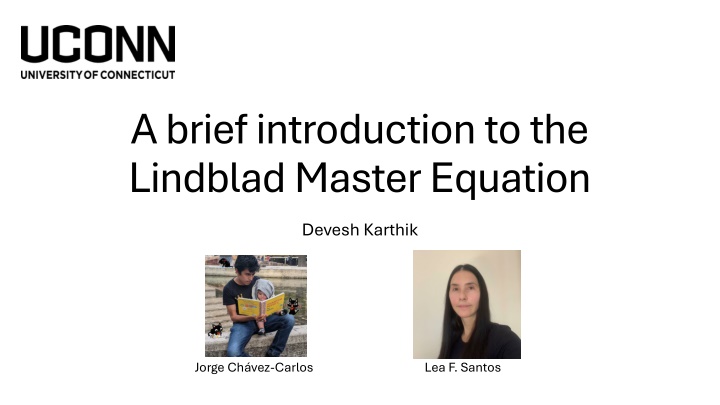
Introduction to Lindblad Master Equation and Quantum Systems
Explore the Lindblad Master Equation and its applications in quantum systems. Discover the properties of density matrices, the von Neumann equation, time evolution in closed and open quantum systems, and the Kerr Parametric Oscillator. Learn about solving linear differential equations, survival probabilities, and interactions in quantum systems. Dive into the realm of open quantum systems and chemical simulators using superconducting circuits.
Download Presentation

Please find below an Image/Link to download the presentation.
The content on the website is provided AS IS for your information and personal use only. It may not be sold, licensed, or shared on other websites without obtaining consent from the author. If you encounter any issues during the download, it is possible that the publisher has removed the file from their server.
You are allowed to download the files provided on this website for personal or commercial use, subject to the condition that they are used lawfully. All files are the property of their respective owners.
The content on the website is provided AS IS for your information and personal use only. It may not be sold, licensed, or shared on other websites without obtaining consent from the author.
E N D
Presentation Transcript
A brief introduction to the Lindblad Master Equation Devesh Karthik Jorge Ch vez-Carlos Lea F. Santos
Outline Lindblad Equation introduction Kerr Parametric Oscillator (KPO) Interactive Example
Closed Quantum Systems System does not interact with environment Density Matrix: Schr dinger Equation: ? ? ? ????? ?? ??? = ? ? , = 1 For a finite ? dimensional system: ?00 ?01 ?1? ??? Density Matrix in Fock-Liouville Hilbert Space has dimension ?2: ? =
Properties of Density Matrices Normalized & Hermitian: Tr ? = 1, ? = ? Idempotent: ?2= ? Positive: non-negative eigenvalues Expectation values: ? = Tr ?? Reduced Density Matrix: ??= Tr????
The von Neumann Equation Calculation for time evolution of states in closed system: ? =?? ? ?????? ??+ ? ???? ??= ????? ? = ?? ????? ??+ ????? ???? = ? ?? ?? ? = ? ?,? | ? = ?|? , ? is matrix of dimension ?2 ?2
Time Evolution in Quantum Systems Solving the von Neumann linear diff eq provides solution: |? ? = exp ? |?0 Vector of dimension ?2 maps to matrix of dimension ? ? |? ? ?(?) Survival probability: autocorrelation function determining similarity of current state ? ? with initial state ?0 SP ? = Tr ?0? ?
Open Quantum Systems ??? = ? + ??+ ?? ?? Interaction
Lindblad Master Equation Gives time evolution of an open system: ?? ??= ? ?,? + 1 ??,? ???????? 2?? are dissipators, ?? is the amplitude of dissipation ?? and ?? | ? = |? , is the Lindblad operator of dimension ?2 ?2 |? ? = exp ? |?0
System Used: Kerr Parametric Oscillators Hamiltonian to create chemical simulators (Yale University) using superconducting circuits (KPO): ? = ? ? + ?? 2?2 2 ? 2+ ?2 1? + ? Kerr Non-Linearity: ? Control Parameter: 1 Control Parameter: 2 Detuning parameter:
System Used: Open System Dissipation: ? = 0.1 Mean photon number in Environment: ? = 0.1 Dissipators: ?1= ?, ?2= ? Amplitudes of Dissipation: ?1= ? ? + 1 , ?2= ??
Quantum Dynamics Dissipation Survival Probability over Time Survival Probability over Time 1= 2, 2= 8, = 0 ??: decay of survival probability, calculated through SVD S.P. S.P. SVD: Single Value Decomposition method Time Time Black: Survival Probability Blue: exp 2?? TX
1,2 Model = 0 ? = 1 ? = ? 2?2 2 ? 2+ ?2 1? + ? Research from Yale University
1,2 Model = 0 ? = 1 ? = ? 2?2 2 ? 2+ ?2 1? + ? White line from classical Hamiltonian: 27??1 o 1 min/point below o 3 CP/point above 3= 0 2 16?2 Plot Resolution: 50 50 points
,1 Model (Exciton Polariton) ?1= 32 ?2= 0 ? = 1 ? = ? ? + ?? 2?2 1? + ? C.P. ~ / ?= 1 Plot Resolution: 2000 points
Interactive Example Example from paper used to study quantum trajectories method explored by Isaias Vallejo & Jorge Ch vez-Carlos : https://doi.org/10.1371/journal.pone.0208263 Isaias Vallejo 5 100 ?0 = 0 =1 ? =2? 0 1 1 0 0 1 1 0 ?0= 0 10 Hamiltonian Initial State Dissipator
Exercise: Survival Probability from ? [0,10] ? = ?? 2?2 2 ? 2+ ?2 Hamiltonian Dimension: 15 Dissipators: ?1= ?,?2= ? ? = 0.1, ? = 0.1 ? = 1, 2= 3, ?1= ? ? + 1 , ?2= ?? Initial state: Ground State ?0
References https://doi.org/10.1063/1.5115323 https://doi.org/10.1371/journal.pone.0208263 https://doi.org/10.48550/arXiv.1110.2122






















